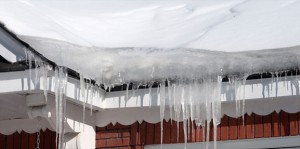 If you live in Central New York, you've probably had ice back up on the edge of your roof. A friend of mine sustained over $20,000 worth of damage to his front porch when a huge block of ice fell on it from the roof. The ice had backed up and formed along the length of the front of the house.
If you live in Central New York, you've probably had ice back up on the edge of your roof. A friend of mine sustained over $20,000 worth of damage to his front porch when a huge block of ice fell on it from the roof. The ice had backed up and formed along the length of the front of the house.
During a March thaw, it came crashing down, destroying the metal roof and decorative wood spindles. He works at his home in an office built in a section of the attic and he told me the sound of the ice crashing down sounded like a bomb hit the house.
Fortunately, his homeowners insurance covered the loss, but he asked me about whether he should blow more insulation in to prevent it from happening again.
You Can Get Rid of Ice Damming Once and For All
The first thought that comes to most people when they have an ice dam problem is to look into more insulation. It seems to make sense to keep the cold out of your house, not only to save money on heating costs, but also to keep ice dams from forming on the eaves.
And insulation is a good idea for a number of reasons. It does save on fuel and with heating oil here in the Mohawk Valley at an astronomical $4 per gallon, the cost of the insulation is recovered very quickly in saved heat costs. Plus, there are incentive programs from the state to help pay for insulation.
So insulation and a snow rake are typical approaches to fixing the problem. But there's another reason that ice dams form on your roof.
The Value of Ventilation in Preventing Ice Damming
Okay, so insulation is a great idea for your home or commercial building. But another (and often overlooked) reason ice forms on your roof is that your attic is warmer than the outside air temperature. The warm attic air heats the roof deck in the attic and begins to melt the snow on the roof. The melted snow then flows down the roof until the water hits a cold surface such as ice filled gutters and unheated overhangs, or the colder evening temperatures.
The next day, the process starts all over and the ice dam begins to act as a stop for the snow water. If not corrected, the ice dam will begin to extend up the roof's surface. The asphalt shingles of your roof are not designed as water barriers. And if you do not have an appropriate water shield on your roof deck below the shingles, water will begin to migrate into the attic space. However, if the interior attic air (ie the interior side of the roof deck) is the same temperature as the exterior air, then this process is halted.
Proper attic ventilation is the key. You must have the attic analyzed for the proper soffit vents, ridge vents, and, if needed, gable vents (on the vertical face wall). The attic square footage, space, and circulation are considered. You want ventilation on the lowest point of the roof and at the highest point to help ensure that you have proper air movement.
This is a big problem in Upstate New York, but with properly installed insulation combined with proper ventilation, it can be fixed so you don't have to worry about it during our long winter seasons. Or have to haul that snow rake out or remove the snow from the roof yourself.
Until next time,
Dan Berkhoudt, Architect
Daniel Berkhoudt, AIA, LEED-AP is an experienced architect working in Utica, Rome, and Central New York. He specializes in new building construction and renovation both commercial and residential. Call 315.737.4416 or contact here.




Leave a Comment